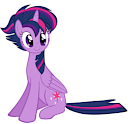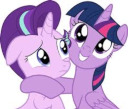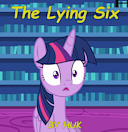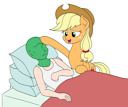Chapter 1
Preface
Welcome friends! It is an exciting time for all of Equestria. The return of humans to our world has caused no end of exuberation. All known cultures have myths and legends regarding humans. Princesses Celestia and Luna say that their great great Granddam told them stories of humans as foals. The Caribou refer to them as Megankin and revere them as the Keepers of their warriors’ paradise. The Yaks call them the First Honorary Yak, but are vague as to what that entails. To the Buffalo, they are a Great Guardian Spirit of the First Buffalo. Minotaur iconography uses human forms as the abstract representation of parental care and strength. Even the Zebra shaman spiritualism views them as a spirit mother. [1]
At the request of the other princesses, I will attempt here to separate fact from myth in order to put forward general information about these ancient and mysterious creatures. This guide is intended to be easily digestible by the laypony while maintaining its scholastic validity. It is my sincerest hope that this guide will continue to smooth pony-human relations for generations to come.
Princess Twilight Sparkle
(Grammatical note: you may notice that the word “human” is never capitalized unlike the names of the other races. This is intentional. Human is a generic term, just like pony. The scientific species name is Homo Sapien Sapiens, while their common species name is Terran. The names for their sun, moon, and planet are treated similarly.)
Abstract
Humans seem to be the guardians and protectors of lore, but have hidden sexual dietary needs. Navigating these needs is imperative not only for the health of humans that may come to Equestria but also to define the nature of pony/human relations. While they are reluctant to allow ponies in, human society is highly promiscuous, polyamorous, and pansexual.
Preliminary Overview
Humans are a supernatural--some would say unnatural--relative of the bonobo. Physically they're extremely frail and weak creatures. They lack wings, horns, hooves, claws, scales, fangs, or feathers to protect them. [2] Nor do they possess the great strength of Earth Ponies or Minotaurs. Additionally, they come from an unnatural world much like the Everfree forest. [4] This reinforces the notion that they are unnatural several ways. Not only is their origin from such an unnatural place suspect, but also the idea that such a frail species could survive so harsh an environment is as well. Yet against all odds they seem to have not only survived but thrived.
This brings us to the supernatural properties humans are believed to possess as the only reasonable explanation. These supernatural or paranormal abilities are much, much different than those possessed by familiar creatures such as the Cockatrice. When others nearby are threatened, humans display incredible fortitude, persistence, and strength. [3] They are able to travel great distances, overcome hardships, and defeat monsters that logically they should not defeat. The initial impulse to scoff at this claim must be balanced by the weight of evidence in its favor. Not even Tirek himself will contest the story of his defeat to Megan Tireksbane [There is some debate as to the proper name attributed to this hero. While the first name is very consistently Megan or Molly, the last name is different in different accounts. [4] ], which according to surviving lore ended with her “...blast[ing] him straight to Tartarus to suffer for his crimes, leaving a hole in the weeping sky.” [3]
These abilities are not without cost, however. Human fortitude does not prevent damage the way natural and magical protections normally would. It is not like dragon scales, which are near impenetrable, or even a hydras regenerative abilities. Instead, it simply allows them to continue activity despite their severe injury while reducing neither the severity nor the duration of it. Nor can their bodies withstand the forces they channel. Contemporary reports of incidental injuries during monster fighting include strained or torn muscles, dislocated limbs, broken bones, and other potentially life threatening injuries.[2] It is extremely dangerous to threaten a sapient being while a human is nearby. These creatures have a protective instinct that overrides even their own survival instinct. In one observed instance, when asked about a blow that shatters its own hand the human ignored the injury, saying only “If I will do that to myself, imagine what I did to the other guy.” [2]
At this point, I am certain that many readers are reacting in shock and confusion. Many myths and legends talk about the kindness of humans over all other traits, making it easy to gloss over the feats of heroism without critical analysis. Indeed, human sociability is dominated by kindness with the protective instinct being a relatively minor manifestation of that. It is only because of the risks associated with this phenomena that it must preface all other social-sexual behavior. In further sections, we will be exploring the major and minor modes of human social interaction which do explain all of the various lore surrounding them.
Minor Mode: Warrior Mother
The minor mode of interaction is that of a protector-protectorate relationship. This is the default reaction toward most non-human species, sapient and animal alike, as well as very young infants, the very sick, and the very old. [4] This type of relationship has been described variously as “fulfilling,” “heartwarming,” and “draining.” [2] Most likely, this primes the human to quickly enter a combat state in the case that their protectorate is threatened. This sort of relationship is instinctual and likely necessary for good health. It is in this relationship that a human expends the build up of its paranormal reserves. This relationship is prevalent in all levels of human society as a basic structural building block. It is not, however, static. A pony can be a protectorate in the day and a lover or protector in the night. [4] Indeed, that change in relationship will become necessary for ponies interacting with humans to prevent the humans from harming themselves via overexertion and metaphysical starvation.
There are several signs a pony should recognize when a human has adopted them as a protectorate. The human may scold a pony, ling, or being they have adopted, but will never direct anger at them. Instead, they are likely to lash out at nearby inanimate objects if provoked. More telling are their social interactions. Humans will show paternal and grooming behavior- “brushies,” story time, and various lessons. They will listen often and talk rarely. Humans will almost always intervene in physical conflicts. For an adopted pony they will as well as be quick to intervene in social conflicts.
The most definitive indicator of this relationship, however, is shyness in intimate situations. Humans are innately sexual creatures. The protective instinct, however, causes them to hide all things sexual except in rare situations. This is not in regards to just personal sexuality, but all references to sex in culture and also includes embarrassment when confronted with sexuality in others. This behavior is analogous to other mythical creatures hiding their “weak points” or vulnerabilities. Consequently, sexual behavior aimed at an adopted pony is extremely curtailed- limited to snuggling, petting, and grooming behaviors. [4]
Major Mode: Lover
If humans expend their metaphysical reserves on others, then just as certainly they must have a means of building them up. Direct observations of human culture is still unavailable. However observations of their closest relatives, the bonobo, coupled with follow up testing on the humans available can form the basis of our understanding of human culture. [5] While the sample size is very small, there is no reason to doubt that the conclusions are very very close to actual human behavior.
Just as Dragons must have a semi-lithovorous lifestyle to maintain their dragon fire in addition to their nutritional needs, humans as well require a special lifestyle. For humans the fruits, grains, and vegetables they eat are needed for their nutritional needs (note: while humans do enjoy fish like Griffons, unlike Griffons this is a type of buffer against malnutrition and not a strict necessity.) [2] Additionally, they require large but not regular quantities of alcohol and sex. Ponies should not worry about fulfilling these needs. Much like transformed changelings, humans do not harm their partners during feeding. While strict emotivores like changelings can feed directly off of their key emotion, humans ability to feed in this manner is highly enhanced by environmental factors. Dancing, alcohol, music, and large groups are all conductive to “recharging” a human. [4, 5]
Our best reconstruction of human culture is that of one highly sexualized and stratified between major and minor modes. Each calling a human might pursue falls into a major or minor template. Human heros, athletes, and guards are the “competitive” fields that compose those minor occupations. Most other occupations are “cooperative.” Chefs, healers, and so on are major occupations. These are associated with the emotivorous needs. Therefore “competitive” and “cooperative” are synonyms for the minor and major modes, although they’re not extensively used here. All known human occupations are associated with one of these modes.
Unlike ponies who have a single cutie mark destiny, humans will change occupations three or more times in their lives. This transition is subject to much ritual and tradition. The transition from one occupation to the next begins when a human “retires.” The hero caste will inevitably transition to a lifestyle of “wine, women, and song” after they retire. This generally involves purchasing a bar or other establishment focused on alcoholic beverages. The guard caste will usually transition to the culinary arts as a chef, or more rarely to medicine. Athletes will also enter the culinary arts, if usually more focused on hosting, or strangely apparel. The transitional period culminates with a series of tests to prove competency. Overall, these transitions are sensible recuperative measures for human emotivorous needs.
Transitioning from a protectorate to a lover is an analogous process known as seduction. There are many rituals and traditions, most of which are still unknown, associated with this. The basic idea is the same however. On the individual level, this comprises a process of getting the human to “come out of their shell” and “open up.” The human will come to accept sexual activity after certain displays of prowess and knowledge. Simply asking is fruitless; part of the test is to know what proficiencies you must display. Still, this transition is necessary to stand on equal footing with a human both for individuals and nations. Without it, they will forever view the subject as possessing a type of childlike innocence.
All signs point to sexuality being integrated to all points of daily life. This is normal for closely related primates. The inefficient emotivorous feeding coupled with the absurd abilities it fuels also point to large portions of their activities focused on restoring their reserves. Combined with the dangerous and unnatural human world, this hyper sexuality is all but assured. Sexual activity is normal on greeting, during meals, as family bonding, and as conflict resolution.
Humans are polyamorous pansexuals. Polyamorous means that they form large romantic and sexual groups. Unlike herds, these groups are not static nor exclusive. Humans will continue to have sexual contact throughout the day with others outside their group. The main indicator of membership in a humans polyamory group is consecutive shared sleeping arrangements. Sleeping together more than three consecutive nights will indicate this. Pansexuality refers to the variety of human sexual partners. Humans will engage in sexual activity with sapient beings of any age, familial relationship, race, or gender. Even rarely sexual relationships with non sapient beings are pursued. Variety in sexual partners is likely a way of adding “flavor” to their emotivorous needs. Indeed, the variety of sexual games they indulge in private is astounding. It is unfortunately too large a topic to fit within the confines of this publication. [5]
Care And Feeding Your Human
Here we will go over a typical routine for keeping a human in your life healthy, should you be so lucky to have one. We should note that these tasks ought to be shared among the ponies that cohabit with a human. I would recommend a schedule to promote friendship and minimize jealousy. There are a lot of novel challenges with humans, mostly centered around their sexual dietary needs. Before embarking on such a task, ponies should ask themselves several questions: Are you comfortable with the ponies you'll be living with, both in sexual and non sexual situations? Do you have sufficient variety in your types to fulfill your humans needs, at the very least several mares and stallions? Are you sufficiently attracted to all the ponies you'll be cohabitating with? Are you able to make sexual advances at your human, to prevent them from getting locked into a protector mode? If the answer to all this is yes, you should feel comfortable proceeding.
Humans will naturally tend to sleep in. Waking them up is safest done via light masturbation followed by oral sex. Next is a breakfast of pancakes, orange juice, and eggs. This should be followed by a grooming session. Sexual activity during and following the grooming is optional, and may range from light teasing to full on mounting. Once your human is ready for the day, you should send it out with a prepared lunch. Lunch can be any two of a soup, salad, or sandwich. Humans have natural talents for a number of tasks, and during the day ought to be allowed to pursue those interests with other ponies. They will return in the evenings for dinner. This meal is a good time to incorporate fish into your humans diet. After dinner, humans will want to engage in relaxing activities to unwind, including sex. After being sexually sated, it will fall into a deep sleep.
Of course, this routine will not play out in exactly the same manner each day; perhaps there is a monster attack, or simply a holiday. A little bit of flexibility and a lot of understanding will get you through.
Conclusion
The humans’ world offers wonderful things for every pony to discover. There might be thousands or even tens of thousands of new humans for ponies to interact with. With a little friendship, kindness, loyalty, laughter, honesty, and generosity the return of humans to our world promises nothing but harmony for everypony.
Bibliography
[1] Tale Teller. Comparative iconography of foundational myths. Canterlot school for gifted unicorns.
[2] Hippocratic Oath. Intake Examination of an Unknown Specimen. Ponyville Hospital.
[3] Tale Teller. Myths of the Founding. Canterlot school for gifted unicorns
[4] Lyra Heartstrings. Humans are Real: Humans in Myth and Fact.
[5] Twilight Sparkle. Comparative Analysis and Experimentation: Bonobo and Human Behavior. Royal Library of Canterlot.









Ok this is...odd. Why the comparison to bonobos? On a somewhat different note this kinda of reminds me of several articles that endlessly romanticized bonobo society while downplaying or ignoring the negative traits.
8646067
I think perhaps you answered your own question. Overall, though, yes.Everything that falls out of my brain is odd. I like the juxtaposition of what we perceive and what is.
Interesting at first, but we really don't have any concrete numbers to legitimize it. Basically, it sounds like she wrote a paper on an entire species by studying a single amorous individual. Honestly Twilight, where's your scholastic integrity?
8646189
I suppose we'd have to look at her 5th citation to know for sure. To the Canterlot royal library!
Ah, I do love the "through alien eyes" trope. This was delightful - and makes one quite suspicious about what sort of human Twilight had been hanging around.
I like it.
Uh so I see someone must have writers block with that master's thesis/research paper/report
Also she forgot our insatiable need to go very fast even though we lack all the stuff pegasuses have to facilitate that.
So flying rides and skydives are manditory! But only under proper supervision as to not seriously injure them
8647614
That is a significant oversight.
Dear princess twilight sparkle, we regret to inform you that due to this terrible thesis, war has broken out with the humans. We have no idea why though. We are writing to ask you for another thesis on the matter.
Sincerely
The Royal Institute of Xenobiology
One of the nicest things about humans I ever heard
8649036
8646544
...are you referencing a different story? I can't tell.
8650033
No, all the citations are fictitious.
After reading through, I saw that annotation 4 was info taken from Lyra's work. I thought to myself, "wait, that seems fishy" and decided to find the number throughout this page. It started well enough, with a factoid from g1 and our world being similar to Everfree... Then...
Yeah, classic Lyra.